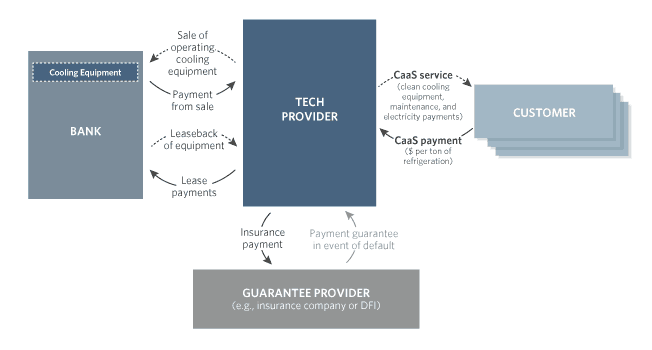Limiting emissions from air conditioning and cooling systems is critical to achieving global climate goals. Space cooling accounts for 10% of global electricity consumption, and fugitive emissions of refrigerants like hydrofluorocarbons (HFCs) can have 200-20,000 times the global warming potential of carbon dioxide.
Global cooling demand is projected to triple by 2050, and phasing out HFC coolants in accordance with the Kigali Amendment to the Montreal Protocol has the potential to reduce warming by 0.4-0.5ºC through 2100. Cleaner and more efficient cooling technologies exist, but they face major barriers to financing and deployment at scale. These include the upfront costs of equipment and installation, perceived technology risks associated with new and innovative clean cooling equipment, and poor stakeholder incentives to pursue efficiency.
Cooling as a Service accelerates deployment of clean cooling technology at scale in emerging markets, by lowering upfront equipment costs and aligning incentives for the most efficient operations and maintenance.
INNOVATION
Cooling as a Service (CaaS) is a pay-per-service model for clean cooling systems, which eliminates upfront investment in clean cooling technology for customers who instead pay per unit of cooling they consume, strengthening incentives for efficient consumption. The technology provider is incentivized to install and maintain the most efficient equipment possible, and, when needed, finance providers have the security of owning an operating asset under a CaaS contract with a customer. This cooling business model is cheaper for customers and more profitable for technology providers – due to both reduced electricity consumption and more effective investment in preventative maintenance.CaaS saves up to 23% of cooling costs for customers and reduces emissions from electricity use and coolant leakage by up to 49% while providing significant profits for both technology and finance providers.
IMPACT
CaaS proponents, BASE and K-CEP, have made significant progress towards initial implementation in two countries: the Dominican Republic and Jamaica. Proponents are also pursuing three to four larger flagship implementation projects, likely including South Africa, India, and Mexico.
Mexico is one of many markets around the world poised for growth in cooling demand. In Mexico, installation and operation for seven years of a single 1200-TR (tons of refrigeration) high-efficiency chiller through CaaS yields a reduction of nearly 18,000 tonnes of CO2 emissions when compared to the operation of a legacy low-efficiency unit over the same period. This emissions reduction from a single system is equivalent to the energy use of 1,945 homes for one year.
DESIGN

A CaaS transaction begins when a cooling system service provider signs an agreement with one or several customers. Under the contract, the provider (or a financier) owns the equipment and commits to maintenance, repairs, and utility bill payment. The provider has significant incentives to achieve high-quality preventive maintenance, reduce corrective maintenance costs, and improve system energy efficiency.
The cooling technology provider is likely to require recapitalization, especially if the provider scales to multiple CaaS contracts. Under one such recapitalization approach – a sale-leaseback – a bank or financial institution would purchase equipment and then lease it back to the cooling system service provider over a period no more than the CaaS contract period.
Customers do not pay an upfront cost for equipment and installation, but instead pay a fee per ton hour of refrigeration consumed – encompassing all equipment, operation, and maintenance costs and profit margins for the technology provider. This fee per unit of consumption is higher than what the customer would pay per unit of electricity under a conventional cooling ownership model, so the customer has a stronger incentive to minimize cooling consumption.

